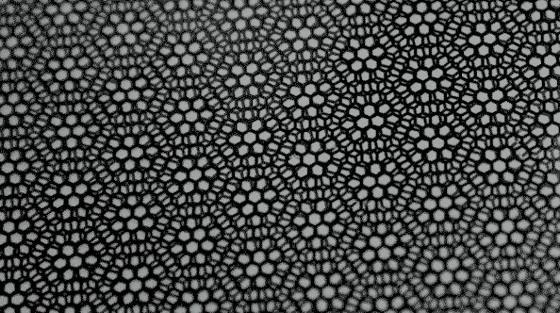There is a Japanese researcher who supports the dream material 'graphene' from behind

The
Meet the crystal growers who sparked a revolution in graphene electronics
https://www.nature.com/articles/d41586-019-02472-0
Mr. Nao Taniguchi and Kenji Watanabe, researchers at the National Institute for Materials Science (NIMS) , are known for creating the world's finest high-purity hexagonal boron nitride (hBN) single crystals. In the past decade, we have been providing hBN free of charge to hundreds of research groups.

Making graphene itself is actually easy, just peel off the carbon layer from the pencil core with adhesive tape. However, in order to study the complex electronic properties of graphene, it is necessary to place graphene on a “perfectly flat surface that does not interfere with electrons moving through graphene”. What is used here is the single crystal of hBN produced by Mr. Taniguchi and Mr. Watanabe. In 2018, a specific angle “
Originally, Mr. Watanabe and Mr. Taniguchi were not graphene researchers, and they did not think that the crystals they created would be important for graphene research. The two have several patents on the manufacture of hBN, but they are unlikely to be commercialized and only the research group needs crystals. However, since many graphene researchers need crystals, their names appear in 180 papers in 2018 alone, and are said to be “the researchers who published the most papers in the world”.

The hydraulic press that Taniguchi uses to generate hBN was manufactured between 1982 and 1984 at a research institute in Tsukuba. After serving as a postdoctoral fellow at Tokyo Institute of Technology, Taniguchi started research on boron nitride (cBN) at the National Institute for Materials Science (NIMS) in Tsukuba City. In the 1990s, the Japanese government started a research program called “Beyond Diamond” and was looking for materials that could be used as semiconductors or cut materials. HBN was born as a by-product of this research.
Mr. Watanabe joined NIMS in 1994, when the Beyond Diamond program was launched. After spending several years researching the optical properties of diamonds, the research institution promoted collaboration in 2001 and contacted Taniguchi.
Mr. Taniguchi originally thought that by-product hBN was 'insignificant', but Mr. Watanabe discovered that hBN glows when exposed to ultraviolet light. “It was the most exciting moment in my career,” says Watanabe. In 2004, they announced that hBN could be a promising crystal for UV lasers. In the same year, the separation of single atomic layers of graphene succeeded, and enthusiasm for graphene increased, but although they were closely observing these studies, `` I had no knowledge of two-dimensional materials '' That's it.
Mr. Taniguchi in front of the hydraulic press.

In 2009, graphene research hit a big wall. Theoretically, the potential of graphene is very large, but we did not find the “perfectly flat substrate that does not contain impurities and do not interfere with the graphene electrons” necessary for actual research.
While struggling to communicate several times, graphene researchers contacted Mr. Watanabe and Mr. Taniguchi to obtain hBN made by them in order to use hBN as a substrate. When I actually used this hBN in my research, the graphene roughness on the substrate was reduced by two-thirds, and the electron mobility was improved 10 to 100 times. Research results were announced in 2010, and researchers working on graphene were also shining. Philip Kim, a graphene researcher, said that it was a sensation. As a result, the crystals created by Mr. Watanabe and Mr. Taniguchi will soon be known among graphene researchers. Suddenly, they were inundated with inquiries and sample requests.
Mr. Taniguchi and Mr. Watanabe have contracted to supply crystals with more than 210 institutions around the world as of 2019. The two don't want to be full co-authors of the paper, but many graphene scientists write their names in the paper as 'authors can't work without their samples' . On the other hand, Mr. Watanabe also revealed that the amount of paperwork for sample supply and publication of papers is enormous and a heavy burden.

by Bernd Klutsch
Not only graphene benefits from hBN, but also substances called transition metal dichalcogenides require hBN for research. Therefore, in addition to Mr. Watanabe and Mr. Taniguchi, Kansas State University research group is also producing hBN, and its quality is gradually improving. Mr. Taniguchi and Mr. Watanabe consider these studies as “those who can work together”.
However, Mr. Taniguchi reached the age of 60 in July 2019 and reached the retirement age. Since Taniguchi's retirement was a concern for graphene researchers, the researchers persuaded Mr. Taniguchi to stay as a NIMS Fellow until the age of 65.
Mr. Taniguchi's recipe for hBN is out of the door, and it is subject to change because it is not always interesting with the same recipe. Despite continuing the work of generating crystals with a hydraulic press for several decades, the scientific process function of what reaction occurs to generate hBN remains a mystery, Exactly a “crystal grower”. “No one knows how to measure, I don't know what is happening or how the crystals are growing. This is just born by imagination,” says Taniguchi.
Related Posts:
in Science, Posted by darkhorse_log






